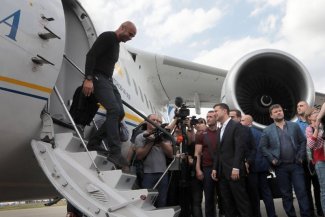Russia and Ukraine exchange prisoners

After months of negotiations, on 7 September an exchange of prisoners took place between Russia and Ukraine, each side sending 35 people. According to media leaks, Ukraine had initially demanded the release of 150 prisoners, while the list submitted by Russia named 34 people. It was announced that talks on exchanging more prisoners will continue (probably on 18 September at a meeting of the so-called contact group in Minsk). The Russian foreign ministry hailed the exchange of prisoners as a first, positive signal indicating the prospects for overcoming the stalemate in relations between the two countries.
Among those freed by Russia were some of Ukraine’s most famous political prisoners. One of them was Oleg Sentsov, a Ukrainian film director who was arrested in 2014 in Crimea, then convicted in a sham trial by a Russian court and sentenced to 20 years’ imprisonment for ‘terrorist activities on the territory of Crimea’. Others released included 24 Ukrainian sailors detained after the so-called Black Sea incident of 25 November 2018, when Ukrainian ships trying to pass through the Kerch Strait were fired on and detained by Russian warships. Further detainees returned to Ukraine included Volodymyr Balukh, an activist from Crimea, the journalist Roman Sushchenko, and Pavlo Hryb, a student abducted while on the territory of Belarus.
Among those returned to Russia was Volodymyr Tsemakh, a commander of the Donbas separatists’ anti-aircraft units, who in June this year was detained and deported from the occupied territories in a bravura raid by the Ukrainian special services. Tsemakh was supposed to be a key witness in the trial of the shooting-down of a Malaysian Airlines Boeing over the Donbas. The Dutch government reacted negatively to Tsemakh’s release (most of the people killed in the crash were Dutch citizens), and according to media reports the prisoner exchange was delayed because Dutch investigators subjected him to additional questioning. Ukraine also freed Kirill Vishinsky, editor-in-chief of the RIA Novosti Ukraina agency, who had been accused of treason by the Ukrainian prosecutor’s office (Vishinsky has dual citizenship). The list of people released from Ukrainian detention also includes several individuals accused of spying for Russia, organising attacks and public disorder.
Commentary
- The agreement to exchange prisoners was intended to demonstrate Moscow’s constructive attitude and win favour from the leaders of France and Germany during the negotiations on the future of the Donbas and the debate within the EU about the future of the current sanctions regime. However, this agreement does not mean that Moscow is ready to make concessions to Kyiv on key political questions regarding the status of the Donbas and Crimea. The Kremlin’s strategy involves forcing Ukraine into decentralisation and granting the Donbas autonomy within the Ukrainian state, which would mean the de facto legitimation of the separatists, and translate into an increase in the influence Moscow can wield over Ukraine. Russia hopes that it can gain international acceptance for such a formula during the planned leaders’ meeting in the so-called Normandy format (France, Germany, Russia and Ukraine), the first in three years, which it hopes will bring about an easing of Western sanctions.
- The prisoner exchange is a success for Ukraine’s new president Volodymyr Zelenskiy, who has shown that he can negotiate effectively with Russia. This will strengthen his domestic position even after criticism of the release of Tsemakh in some media. The government in Kyiv assumes that the return of the 35 Ukrainian prisoners is just the first step in the process of resolving the Donbas conflict. Zelenskiy hopes that he can come to an agreement with Moscow on ending the hostilities, which would fulfil of one of his most important pre-election promises. However, statements made by Ukrainian diplomats lead to the conclusion that Kyiv realises this would entail making painful concessions to Russia. If there is any real progress in the peace process, the main risk for Ukraine’s new government will be how the Ukrainian public reacts. If the active part of society, including veterans of the Donbas conflict, comes to see any such agreement as a betrayal, this could lead to a serious domestic crisis.




